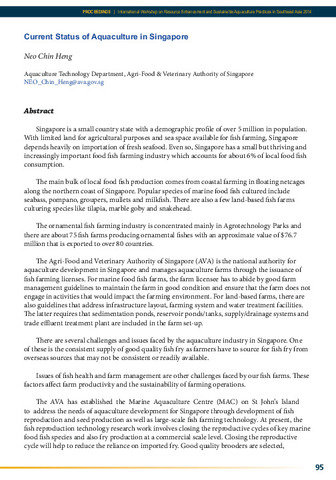Current status of aquaculture in Singapore
| dc.contributor.author | Heng, Neo Chin | |
| dc.contributor.editor | Romana-Eguia, Maria Rowena R. | |
| dc.contributor.editor | Parado-Estepa, Fe D. | |
| dc.contributor.editor | Salayo, Nerissa D. | |
| dc.contributor.editor | Lebata-Ramos, Ma. Junemie Hazel | |
| dc.date.accessioned | 2016-01-20T17:40:27Z | |
| dc.date.available | 2016-01-20T17:40:27Z | |
| dc.date.issued | 2015 | |
| dc.identifier.citation | Heng, N. C. (2015). Current status of aquaculture in Singapore. In M. R. R. Romana-Eguia, F. D. Parado-Estepa, N. D. Salayo, & M. J. H. Lebata-Ramos (Eds.), Resource Enhancement and Sustainable Aquaculture Practices in Southeast Asia: Challenges in Responsible Production of Aquatic Species: Proceedings of the International Workshop on Resource Enhancement and Sustainable Aquaculture Practices in Southeast Asia 2014 (RESA) (pp. 95-96). Tigbauan, Iloilo, Philippines: Aquaculture Department, Southeast Asian Fisheries Development Center. | |
| dc.identifier.isbn | 9789719931041 | |
| dc.identifier.uri | http://hdl.handle.net/10862/2785 | |
| dc.description.abstract | Singapore is a small country state with a demographic profile of over 5 million in population. With limited land for agricultural purposes and sea space available for fish farming, Singapore depends heavily on importation of fresh seafood. Even so, Singapore has a small but thriving and increasingly important food fish farming industry which accounts for about 6% of local food fish consumption. The main bulk of local food fish production comes from coastal farming in floating netcages along the northern coast of Singapore. Popular species of marine food fish cultured include seabass, pompano, groupers, mullets and milkfish. There are also a few land-based fish farms culturing species like tilapia, marble goby and snakehead. The ornamental fish farming industry is concentrated mainly in Agrotechnology Parks and there are about 75 fish farms producing ornamental fishes with an approximate value of $76.7 million that is exported to over 80 countries. The Agri-Food and Veterinary Authority of Singapore (AVA) is the national authority for aquaculture development in Singapore and manages aquaculture farms through the issuance of fish farming licenses. For marine food fish farms, the farm licensee has to abide by good farm management guidelines to maintain the farm in good condition and ensure that the farm does not engage in activities that would impact the farming environment. For land-based farms, there are also guidelines that address infrastructure layout, farming system and water treatment facilities. The latter requires that sedimentation ponds, reservoir ponds/tanks, supply/drainage systems and trade effluent treatment plant are included in the farm set-up. There are several challenges and issues faced by the aquaculture industry in Singapore. One of these is the consistent supply of good quality fish fry as farmers have to source for fish fry from overseas sources that may not be consistent or readily available. Issues of fish health and farm management are other challenges faced by our fish farms. These factors affect farm productivity and the sustainability of farming operations. The AVA has established the Marine Aquaculture Centre (MAC) on St John's Island to address the needs of aquaculture development for Singapore through development of fish reproduction and seed production as well as large-scale fish farming technology. At present, the fish reproduction technology research work involves closing the reproductive cycles of key marine food fish species and also fry production at a commercial scale level. Closing the reproductive cycle will help to reduce the reliance on imported fry. Good quality brooders are selected, maintained and bred to produce quality fry, which would translate to better growth performance and shorter culture period. This, together with good farm management practices, will optimize the usage of fish feeds during the culture cycle. To fill the gap in production and supply of good quality fish seeds for local fish farms, AVA shares information on hatchery technology development with local commercial hatcheries. The AVA collaborates with research institutes and local fish farms in the development of vaccines to boost the survival rate of fish fry and fingerlings. This will improve survivability, thus increase the production of the farms and reduce the reliance on prophylactic drugs that may have negative consequences from prolonged use. The AVA also renders technical assistance to the farmers to formulate viable production plans to improve production. By leveraging on the use of technology and good farm practices, such as implementation of fish health, fish nutrition and feeding protocols, it is possible to reduce production costs and improve productivity. The introduction of the Good Aquaculture Practice scheme for food fish farming will help improve the standards of the local aquaculture industry and sustainability through responsible management practices. | |
| dc.language.iso | en | en |
| dc.publisher | Aquaculture Department, Southeast Asian Fisheries Development Center | en |
| dc.subject | Singapore | en |
| dc.subject | Coastal farming | |
| dc.title | Current status of aquaculture in Singapore | en |
| dc.type | Conference paper | en |
| dc.citation.spage | 95 | |
| dc.citation.epage | 96 | |
| dc.citation.conferenceTitle | Resource Enhancement and Sustainable Aquaculture Practices in Southeast Asia: Challenges in Responsible Production of Aquatic Species: Proceedings of the International Workshop on Resource Enhancement and Sustainable Aquaculture Practices in Southeast Asia 2014 (RESA) | en |
| dc.subject.asfa | ornamental fishes |


